Management Accounting Assignment Solution - UGB106, Term 1, 2020/21
VerifiedAdded on 2023/01/05
|16
|3709
|76
Homework Assignment
AI Summary
This assignment solution addresses key concepts in management accounting through three comprehensive questions. Question 1 focuses on Woodrock Limited, requiring the preparation of a cash budget, analysis of cash flow, and a discussion of the behavioral aspects of budgeting, including dysfunctional behavior, participative budgeting, and budgetary slack. Question 2 examines Plaistead Plc, calculating contribution margin, break-even point, margin of safety, profit, and analyzing the impact of changes in fixed costs and selling prices, along with a discussion of break-even model assumptions. Question 4 centers on Jayrod Plc, involving the preparation of original, flexed, and actual budgets, total variance analysis, and an assessment of the relevance of these budgets. The solution provides detailed calculations and explanations to aid in understanding the core principles of management accounting.
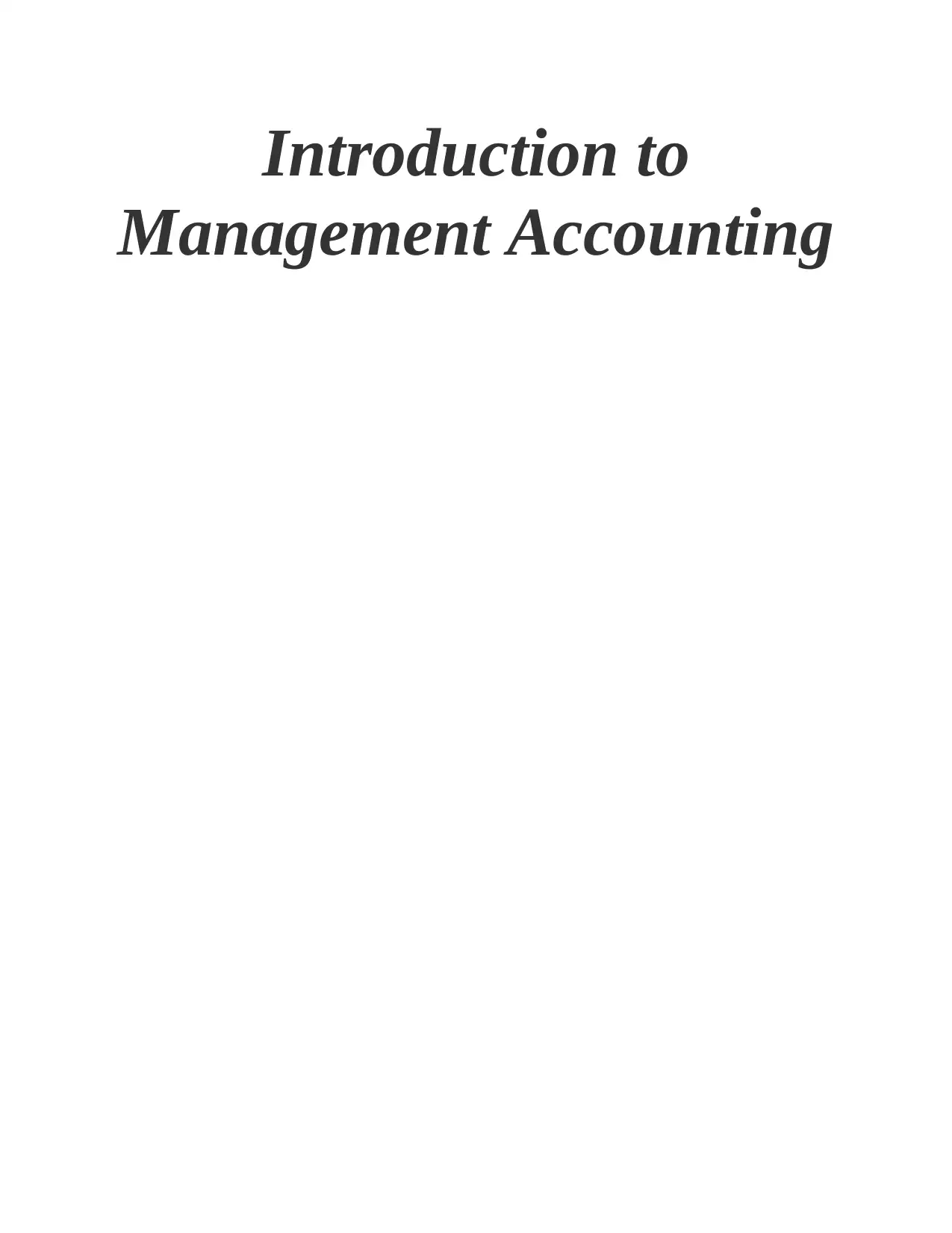
Introduction to
Management Accounting
Management Accounting
Paraphrase This Document
Need a fresh take? Get an instant paraphrase of this document with our AI Paraphraser
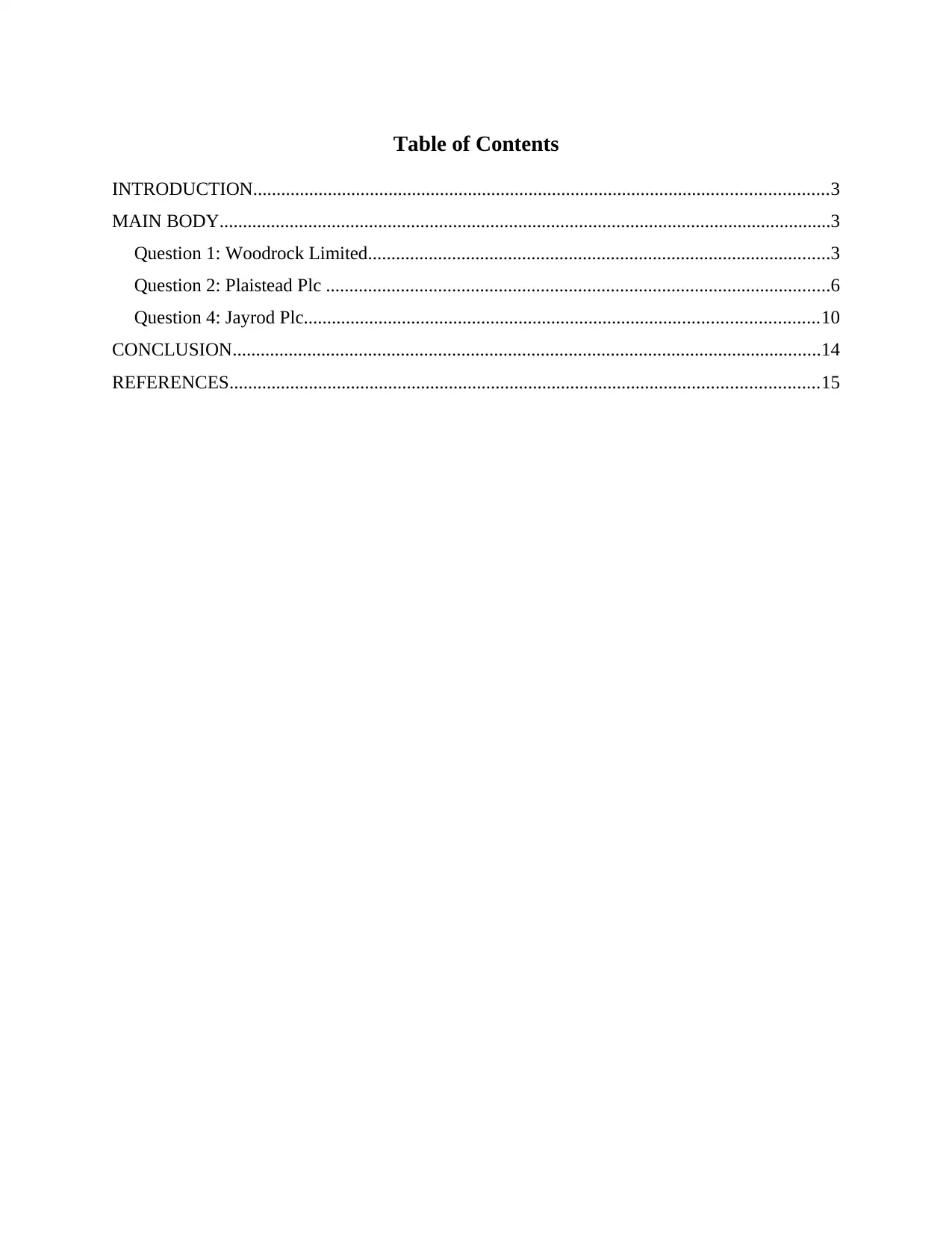
Table of Contents
INTRODUCTION...........................................................................................................................3
MAIN BODY...................................................................................................................................3
Question 1: Woodrock Limited...................................................................................................3
Question 2: Plaistead Plc ............................................................................................................6
Question 4: Jayrod Plc..............................................................................................................10
CONCLUSION..............................................................................................................................14
REFERENCES..............................................................................................................................15
INTRODUCTION...........................................................................................................................3
MAIN BODY...................................................................................................................................3
Question 1: Woodrock Limited...................................................................................................3
Question 2: Plaistead Plc ............................................................................................................6
Question 4: Jayrod Plc..............................................................................................................10
CONCLUSION..............................................................................................................................14
REFERENCES..............................................................................................................................15
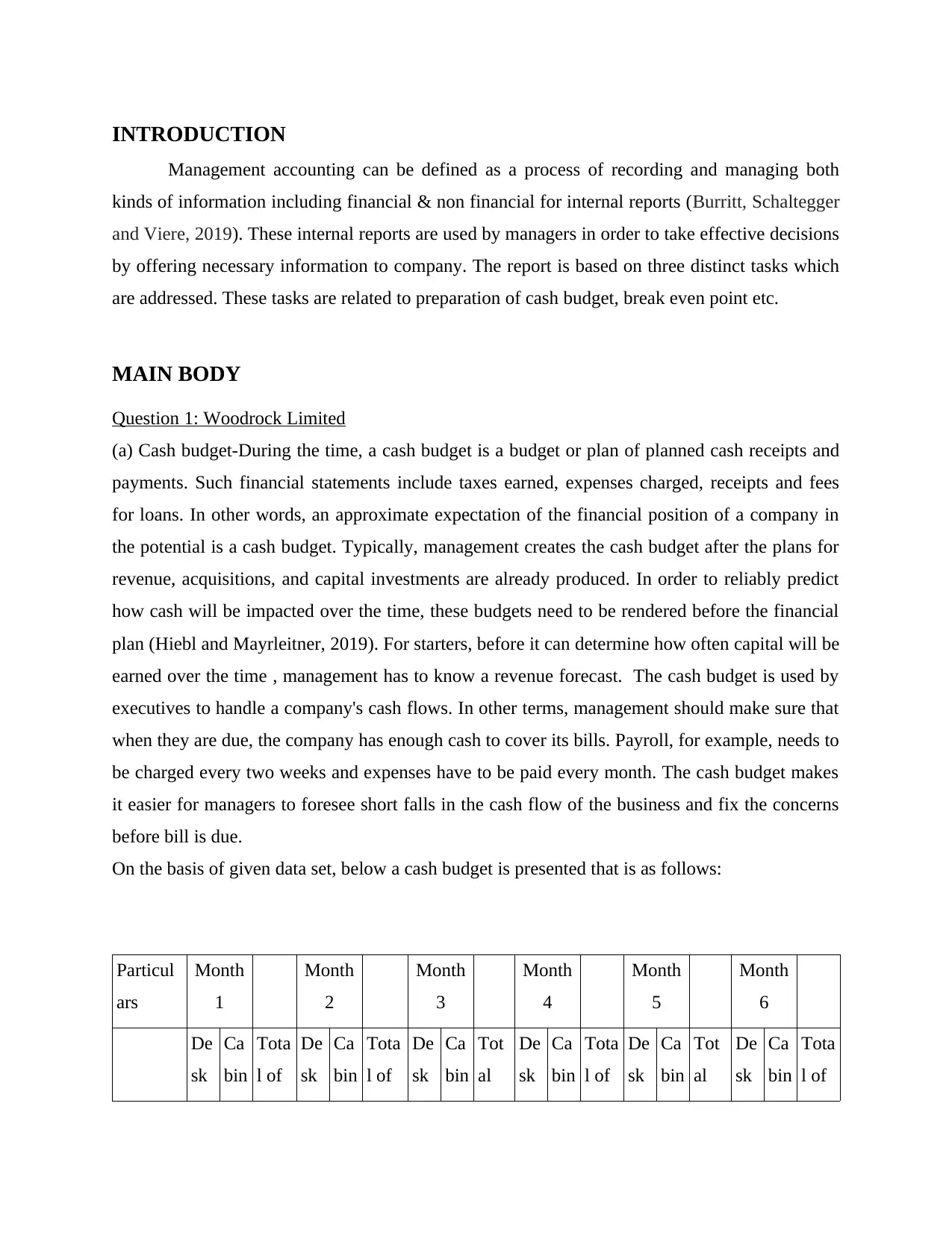
INTRODUCTION
Management accounting can be defined as a process of recording and managing both
kinds of information including financial & non financial for internal reports (Burritt, Schaltegger
and Viere, 2019). These internal reports are used by managers in order to take effective decisions
by offering necessary information to company. The report is based on three distinct tasks which
are addressed. These tasks are related to preparation of cash budget, break even point etc.
MAIN BODY
Question 1: Woodrock Limited
(a) Cash budget-During the time, a cash budget is a budget or plan of planned cash receipts and
payments. Such financial statements include taxes earned, expenses charged, receipts and fees
for loans. In other words, an approximate expectation of the financial position of a company in
the potential is a cash budget. Typically, management creates the cash budget after the plans for
revenue, acquisitions, and capital investments are already produced. In order to reliably predict
how cash will be impacted over the time, these budgets need to be rendered before the financial
plan (Hiebl and Mayrleitner, 2019). For starters, before it can determine how often capital will be
earned over the time , management has to know a revenue forecast. The cash budget is used by
executives to handle a company's cash flows. In other terms, management should make sure that
when they are due, the company has enough cash to cover its bills. Payroll, for example, needs to
be charged every two weeks and expenses have to be paid every month. The cash budget makes
it easier for managers to foresee short falls in the cash flow of the business and fix the concerns
before bill is due.
On the basis of given data set, below a cash budget is presented that is as follows:
Particul
ars
Month
1
Month
2
Month
3
Month
4
Month
5
Month
6
De
sk
Ca
bin
Tota
l of
De
sk
Ca
bin
Tota
l of
De
sk
Ca
bin
Tot
al
De
sk
Ca
bin
Tota
l of
De
sk
Ca
bin
Tot
al
De
sk
Ca
bin
Tota
l of
Management accounting can be defined as a process of recording and managing both
kinds of information including financial & non financial for internal reports (Burritt, Schaltegger
and Viere, 2019). These internal reports are used by managers in order to take effective decisions
by offering necessary information to company. The report is based on three distinct tasks which
are addressed. These tasks are related to preparation of cash budget, break even point etc.
MAIN BODY
Question 1: Woodrock Limited
(a) Cash budget-During the time, a cash budget is a budget or plan of planned cash receipts and
payments. Such financial statements include taxes earned, expenses charged, receipts and fees
for loans. In other words, an approximate expectation of the financial position of a company in
the potential is a cash budget. Typically, management creates the cash budget after the plans for
revenue, acquisitions, and capital investments are already produced. In order to reliably predict
how cash will be impacted over the time, these budgets need to be rendered before the financial
plan (Hiebl and Mayrleitner, 2019). For starters, before it can determine how often capital will be
earned over the time , management has to know a revenue forecast. The cash budget is used by
executives to handle a company's cash flows. In other terms, management should make sure that
when they are due, the company has enough cash to cover its bills. Payroll, for example, needs to
be charged every two weeks and expenses have to be paid every month. The cash budget makes
it easier for managers to foresee short falls in the cash flow of the business and fix the concerns
before bill is due.
On the basis of given data set, below a cash budget is presented that is as follows:
Particul
ars
Month
1
Month
2
Month
3
Month
4
Month
5
Month
6
De
sk
Ca
bin
Tota
l of
De
sk
Ca
bin
Tota
l of
De
sk
Ca
bin
Tot
al
De
sk
Ca
bin
Tota
l of
De
sk
Ca
bin
Tot
al
De
sk
Ca
bin
Tota
l of
⊘ This is a preview!⊘
Do you want full access?
Subscribe today to unlock all pages.

Trusted by 1+ million students worldwide
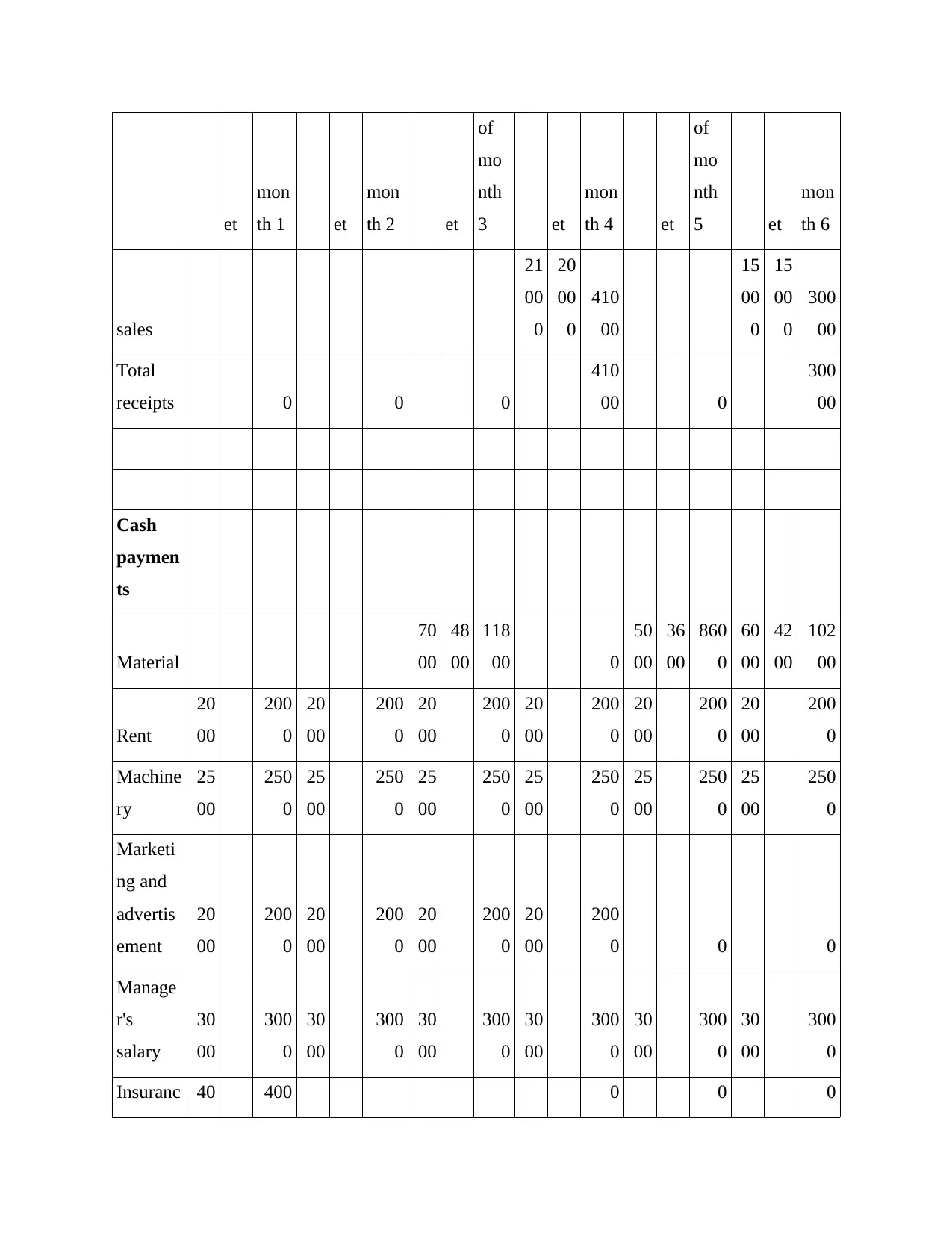
et
mon
th 1 et
mon
th 2 et
of
mo
nth
3 et
mon
th 4 et
of
mo
nth
5 et
mon
th 6
sales
21
00
0
20
00
0
410
00
15
00
0
15
00
0
300
00
Total
receipts 0 0 0
410
00 0
300
00
Cash
paymen
ts
Material
70
00
48
00
118
00 0
50
00
36
00
860
0
60
00
42
00
102
00
Rent
20
00
200
0
20
00
200
0
20
00
200
0
20
00
200
0
20
00
200
0
20
00
200
0
Machine
ry
25
00
250
0
25
00
250
0
25
00
250
0
25
00
250
0
25
00
250
0
25
00
250
0
Marketi
ng and
advertis
ement
20
00
200
0
20
00
200
0
20
00
200
0
20
00
200
0 0 0
Manage
r's
salary
30
00
300
0
30
00
300
0
30
00
300
0
30
00
300
0
30
00
300
0
30
00
300
0
Insuranc 40 400 0 0 0
mon
th 1 et
mon
th 2 et
of
mo
nth
3 et
mon
th 4 et
of
mo
nth
5 et
mon
th 6
sales
21
00
0
20
00
0
410
00
15
00
0
15
00
0
300
00
Total
receipts 0 0 0
410
00 0
300
00
Cash
paymen
ts
Material
70
00
48
00
118
00 0
50
00
36
00
860
0
60
00
42
00
102
00
Rent
20
00
200
0
20
00
200
0
20
00
200
0
20
00
200
0
20
00
200
0
20
00
200
0
Machine
ry
25
00
250
0
25
00
250
0
25
00
250
0
25
00
250
0
25
00
250
0
25
00
250
0
Marketi
ng and
advertis
ement
20
00
200
0
20
00
200
0
20
00
200
0
20
00
200
0 0 0
Manage
r's
salary
30
00
300
0
30
00
300
0
30
00
300
0
30
00
300
0
30
00
300
0
30
00
300
0
Insuranc 40 400 0 0 0
Paraphrase This Document
Need a fresh take? Get an instant paraphrase of this document with our AI Paraphraser
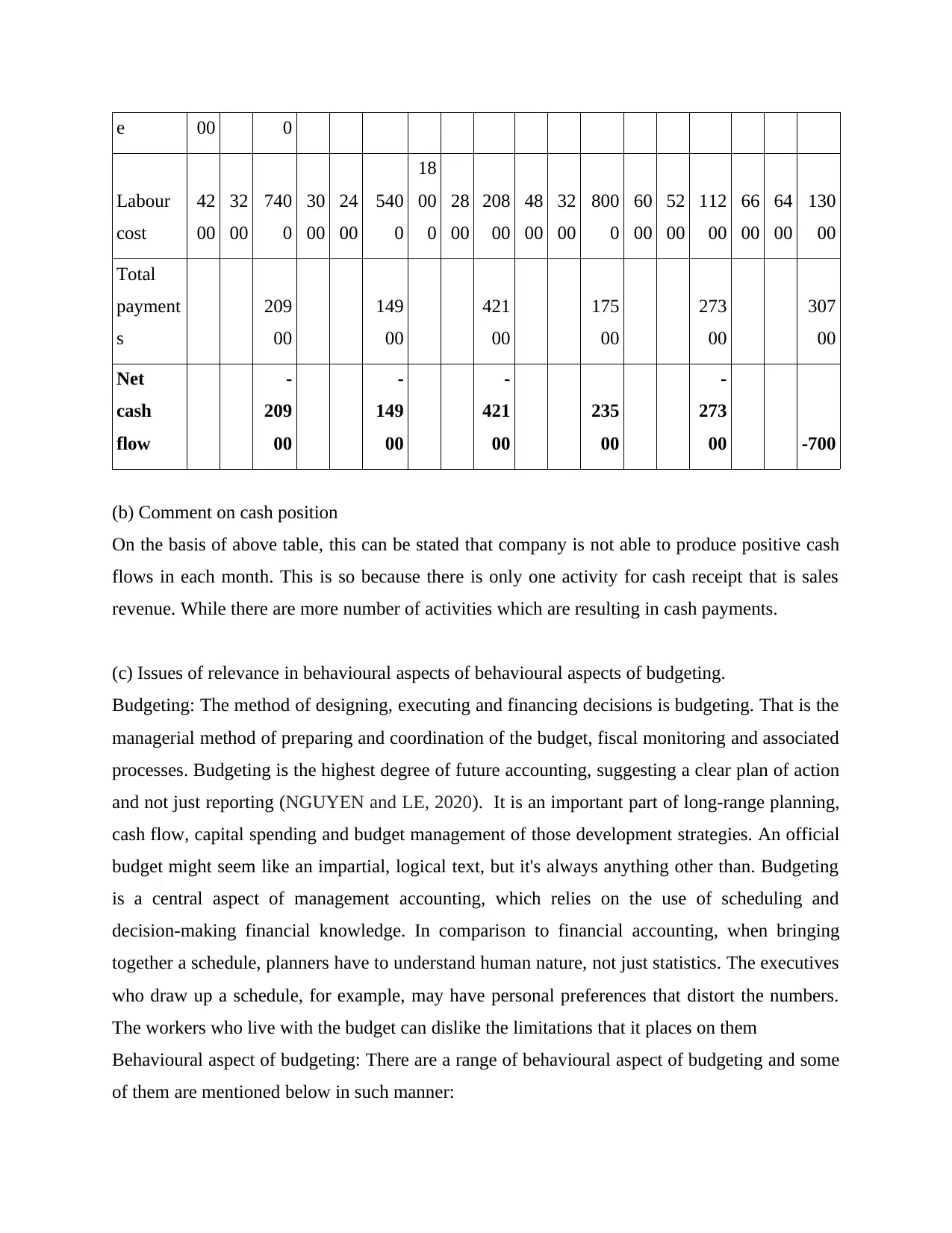
e 00 0
Labour
cost
42
00
32
00
740
0
30
00
24
00
540
0
18
00
0
28
00
208
00
48
00
32
00
800
0
60
00
52
00
112
00
66
00
64
00
130
00
Total
payment
s
209
00
149
00
421
00
175
00
273
00
307
00
Net
cash
flow
-
209
00
-
149
00
-
421
00
235
00
-
273
00 -700
(b) Comment on cash position
On the basis of above table, this can be stated that company is not able to produce positive cash
flows in each month. This is so because there is only one activity for cash receipt that is sales
revenue. While there are more number of activities which are resulting in cash payments.
(c) Issues of relevance in behavioural aspects of behavioural aspects of budgeting.
Budgeting: The method of designing, executing and financing decisions is budgeting. That is the
managerial method of preparing and coordination of the budget, fiscal monitoring and associated
processes. Budgeting is the highest degree of future accounting, suggesting a clear plan of action
and not just reporting (NGUYEN and LE, 2020). It is an important part of long-range planning,
cash flow, capital spending and budget management of those development strategies. An official
budget might seem like an impartial, logical text, but it's always anything other than. Budgeting
is a central aspect of management accounting, which relies on the use of scheduling and
decision-making financial knowledge. In comparison to financial accounting, when bringing
together a schedule, planners have to understand human nature, not just statistics. The executives
who draw up a schedule, for example, may have personal preferences that distort the numbers.
The workers who live with the budget can dislike the limitations that it places on them
Behavioural aspect of budgeting: There are a range of behavioural aspect of budgeting and some
of them are mentioned below in such manner:
Labour
cost
42
00
32
00
740
0
30
00
24
00
540
0
18
00
0
28
00
208
00
48
00
32
00
800
0
60
00
52
00
112
00
66
00
64
00
130
00
Total
payment
s
209
00
149
00
421
00
175
00
273
00
307
00
Net
cash
flow
-
209
00
-
149
00
-
421
00
235
00
-
273
00 -700
(b) Comment on cash position
On the basis of above table, this can be stated that company is not able to produce positive cash
flows in each month. This is so because there is only one activity for cash receipt that is sales
revenue. While there are more number of activities which are resulting in cash payments.
(c) Issues of relevance in behavioural aspects of behavioural aspects of budgeting.
Budgeting: The method of designing, executing and financing decisions is budgeting. That is the
managerial method of preparing and coordination of the budget, fiscal monitoring and associated
processes. Budgeting is the highest degree of future accounting, suggesting a clear plan of action
and not just reporting (NGUYEN and LE, 2020). It is an important part of long-range planning,
cash flow, capital spending and budget management of those development strategies. An official
budget might seem like an impartial, logical text, but it's always anything other than. Budgeting
is a central aspect of management accounting, which relies on the use of scheduling and
decision-making financial knowledge. In comparison to financial accounting, when bringing
together a schedule, planners have to understand human nature, not just statistics. The executives
who draw up a schedule, for example, may have personal preferences that distort the numbers.
The workers who live with the budget can dislike the limitations that it places on them
Behavioural aspect of budgeting: There are a range of behavioural aspect of budgeting and some
of them are mentioned below in such manner:
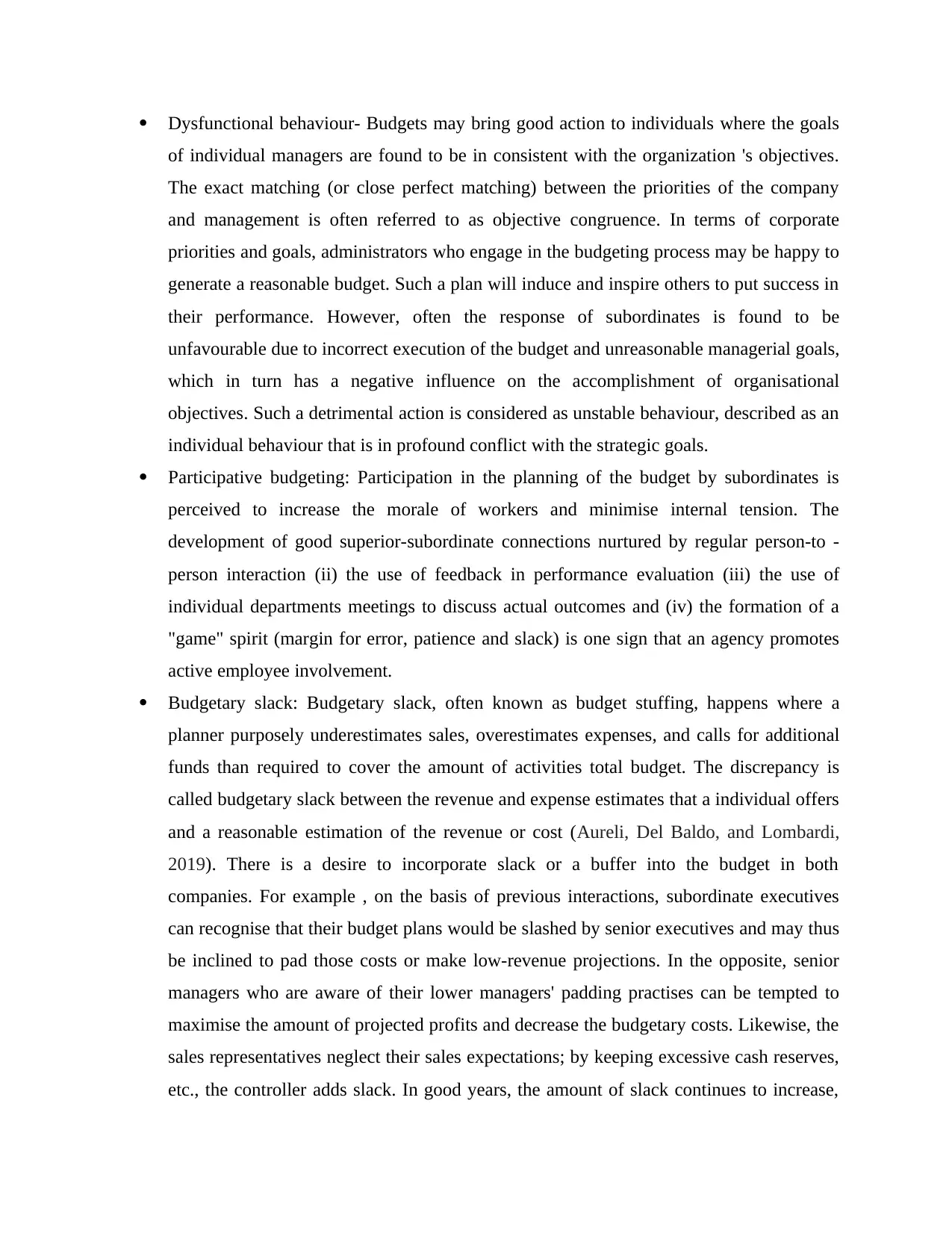
Dysfunctional behaviour- Budgets may bring good action to individuals where the goals
of individual managers are found to be in consistent with the organization 's objectives.
The exact matching (or close perfect matching) between the priorities of the company
and management is often referred to as objective congruence. In terms of corporate
priorities and goals, administrators who engage in the budgeting process may be happy to
generate a reasonable budget. Such a plan will induce and inspire others to put success in
their performance. However, often the response of subordinates is found to be
unfavourable due to incorrect execution of the budget and unreasonable managerial goals,
which in turn has a negative influence on the accomplishment of organisational
objectives. Such a detrimental action is considered as unstable behaviour, described as an
individual behaviour that is in profound conflict with the strategic goals.
Participative budgeting: Participation in the planning of the budget by subordinates is
perceived to increase the morale of workers and minimise internal tension. The
development of good superior-subordinate connections nurtured by regular person-to -
person interaction (ii) the use of feedback in performance evaluation (iii) the use of
individual departments meetings to discuss actual outcomes and (iv) the formation of a
"game" spirit (margin for error, patience and slack) is one sign that an agency promotes
active employee involvement.
Budgetary slack: Budgetary slack, often known as budget stuffing, happens where a
planner purposely underestimates sales, overestimates expenses, and calls for additional
funds than required to cover the amount of activities total budget. The discrepancy is
called budgetary slack between the revenue and expense estimates that a individual offers
and a reasonable estimation of the revenue or cost (Aureli, Del Baldo, and Lombardi,
2019). There is a desire to incorporate slack or a buffer into the budget in both
companies. For example , on the basis of previous interactions, subordinate executives
can recognise that their budget plans would be slashed by senior executives and may thus
be inclined to pad those costs or make low-revenue projections. In the opposite, senior
managers who are aware of their lower managers' padding practises can be tempted to
maximise the amount of projected profits and decrease the budgetary costs. Likewise, the
sales representatives neglect their sales expectations; by keeping excessive cash reserves,
etc., the controller adds slack. In good years, the amount of slack continues to increase,
of individual managers are found to be in consistent with the organization 's objectives.
The exact matching (or close perfect matching) between the priorities of the company
and management is often referred to as objective congruence. In terms of corporate
priorities and goals, administrators who engage in the budgeting process may be happy to
generate a reasonable budget. Such a plan will induce and inspire others to put success in
their performance. However, often the response of subordinates is found to be
unfavourable due to incorrect execution of the budget and unreasonable managerial goals,
which in turn has a negative influence on the accomplishment of organisational
objectives. Such a detrimental action is considered as unstable behaviour, described as an
individual behaviour that is in profound conflict with the strategic goals.
Participative budgeting: Participation in the planning of the budget by subordinates is
perceived to increase the morale of workers and minimise internal tension. The
development of good superior-subordinate connections nurtured by regular person-to -
person interaction (ii) the use of feedback in performance evaluation (iii) the use of
individual departments meetings to discuss actual outcomes and (iv) the formation of a
"game" spirit (margin for error, patience and slack) is one sign that an agency promotes
active employee involvement.
Budgetary slack: Budgetary slack, often known as budget stuffing, happens where a
planner purposely underestimates sales, overestimates expenses, and calls for additional
funds than required to cover the amount of activities total budget. The discrepancy is
called budgetary slack between the revenue and expense estimates that a individual offers
and a reasonable estimation of the revenue or cost (Aureli, Del Baldo, and Lombardi,
2019). There is a desire to incorporate slack or a buffer into the budget in both
companies. For example , on the basis of previous interactions, subordinate executives
can recognise that their budget plans would be slashed by senior executives and may thus
be inclined to pad those costs or make low-revenue projections. In the opposite, senior
managers who are aware of their lower managers' padding practises can be tempted to
maximise the amount of projected profits and decrease the budgetary costs. Likewise, the
sales representatives neglect their sales expectations; by keeping excessive cash reserves,
etc., the controller adds slack. In good years, the amount of slack continues to increase,
⊘ This is a preview!⊘
Do you want full access?
Subscribe today to unlock all pages.

Trusted by 1+ million students worldwide
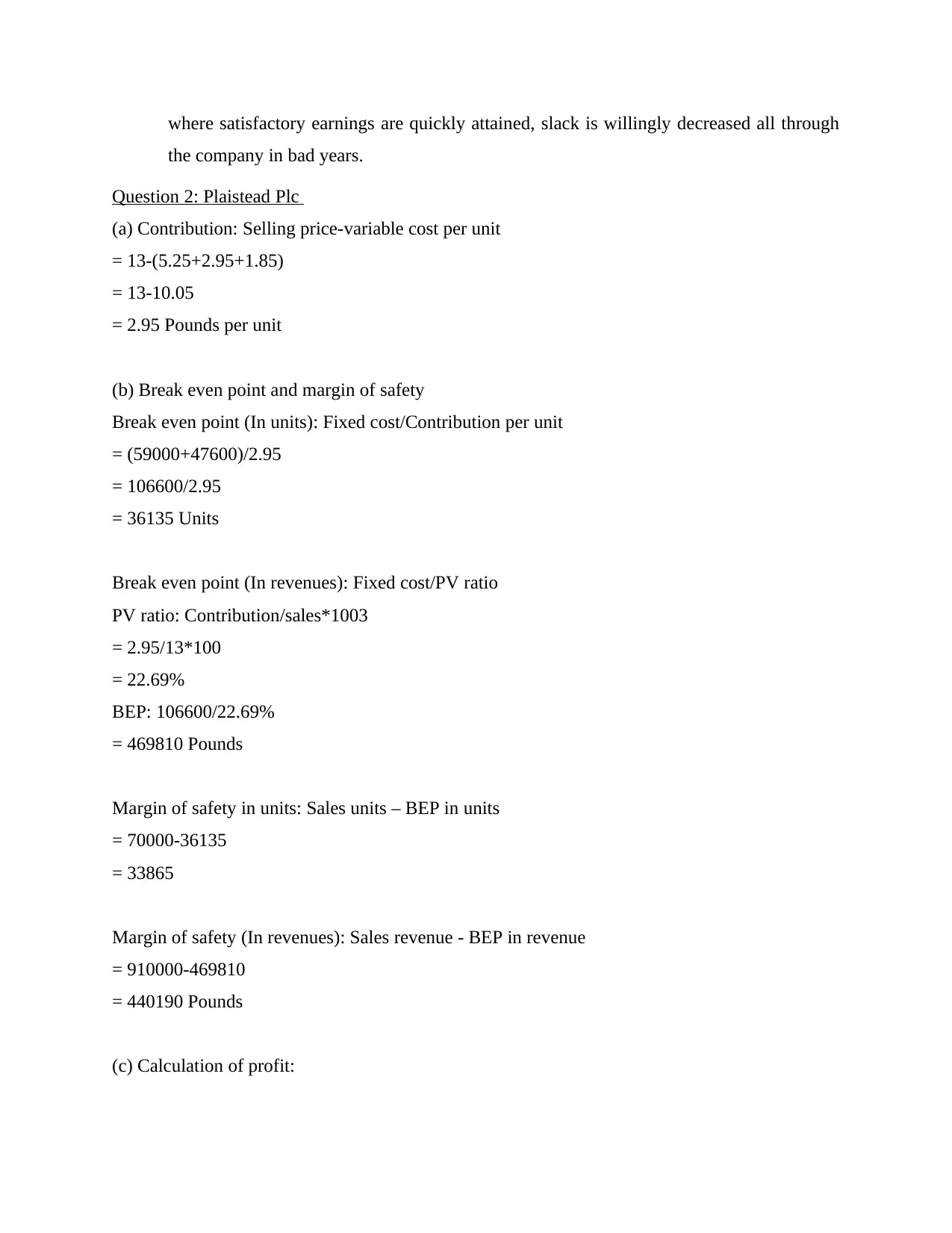
where satisfactory earnings are quickly attained, slack is willingly decreased all through
the company in bad years.
Question 2: Plaistead Plc
(a) Contribution: Selling price-variable cost per unit
= 13-(5.25+2.95+1.85)
= 13-10.05
= 2.95 Pounds per unit
(b) Break even point and margin of safety
Break even point (In units): Fixed cost/Contribution per unit
= (59000+47600)/2.95
= 106600/2.95
= 36135 Units
Break even point (In revenues): Fixed cost/PV ratio
PV ratio: Contribution/sales*1003
= 2.95/13*100
= 22.69%
BEP: 106600/22.69%
= 469810 Pounds
Margin of safety in units: Sales units – BEP in units
= 70000-36135
= 33865
Margin of safety (In revenues): Sales revenue - BEP in revenue
= 910000-469810
= 440190 Pounds
(c) Calculation of profit:
the company in bad years.
Question 2: Plaistead Plc
(a) Contribution: Selling price-variable cost per unit
= 13-(5.25+2.95+1.85)
= 13-10.05
= 2.95 Pounds per unit
(b) Break even point and margin of safety
Break even point (In units): Fixed cost/Contribution per unit
= (59000+47600)/2.95
= 106600/2.95
= 36135 Units
Break even point (In revenues): Fixed cost/PV ratio
PV ratio: Contribution/sales*1003
= 2.95/13*100
= 22.69%
BEP: 106600/22.69%
= 469810 Pounds
Margin of safety in units: Sales units – BEP in units
= 70000-36135
= 33865
Margin of safety (In revenues): Sales revenue - BEP in revenue
= 910000-469810
= 440190 Pounds
(c) Calculation of profit:
Paraphrase This Document
Need a fresh take? Get an instant paraphrase of this document with our AI Paraphraser
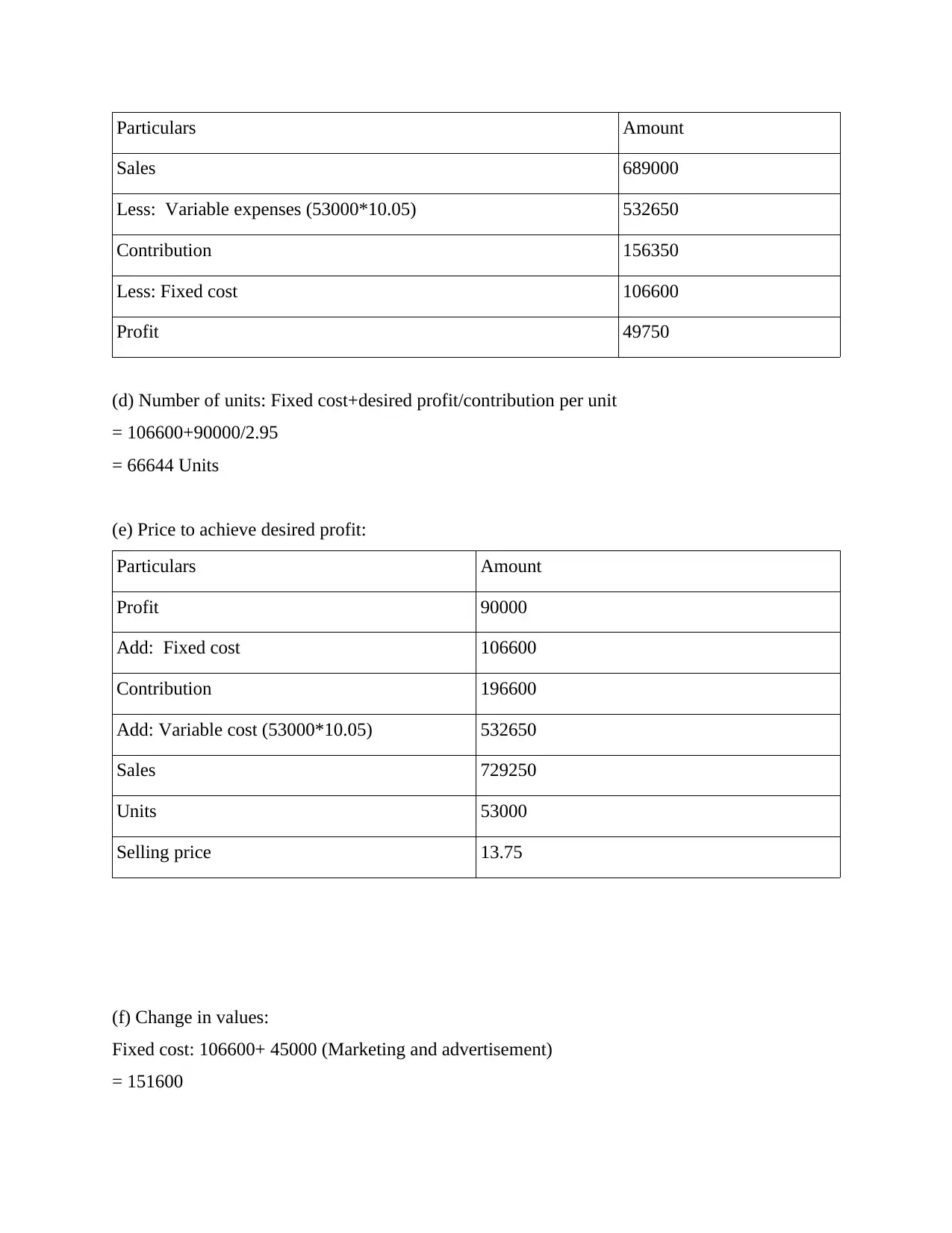
Particulars Amount
Sales 689000
Less: Variable expenses (53000*10.05) 532650
Contribution 156350
Less: Fixed cost 106600
Profit 49750
(d) Number of units: Fixed cost+desired profit/contribution per unit
= 106600+90000/2.95
= 66644 Units
(e) Price to achieve desired profit:
Particulars Amount
Profit 90000
Add: Fixed cost 106600
Contribution 196600
Add: Variable cost (53000*10.05) 532650
Sales 729250
Units 53000
Selling price 13.75
(f) Change in values:
Fixed cost: 106600+ 45000 (Marketing and advertisement)
= 151600
Sales 689000
Less: Variable expenses (53000*10.05) 532650
Contribution 156350
Less: Fixed cost 106600
Profit 49750
(d) Number of units: Fixed cost+desired profit/contribution per unit
= 106600+90000/2.95
= 66644 Units
(e) Price to achieve desired profit:
Particulars Amount
Profit 90000
Add: Fixed cost 106600
Contribution 196600
Add: Variable cost (53000*10.05) 532650
Sales 729250
Units 53000
Selling price 13.75
(f) Change in values:
Fixed cost: 106600+ 45000 (Marketing and advertisement)
= 151600
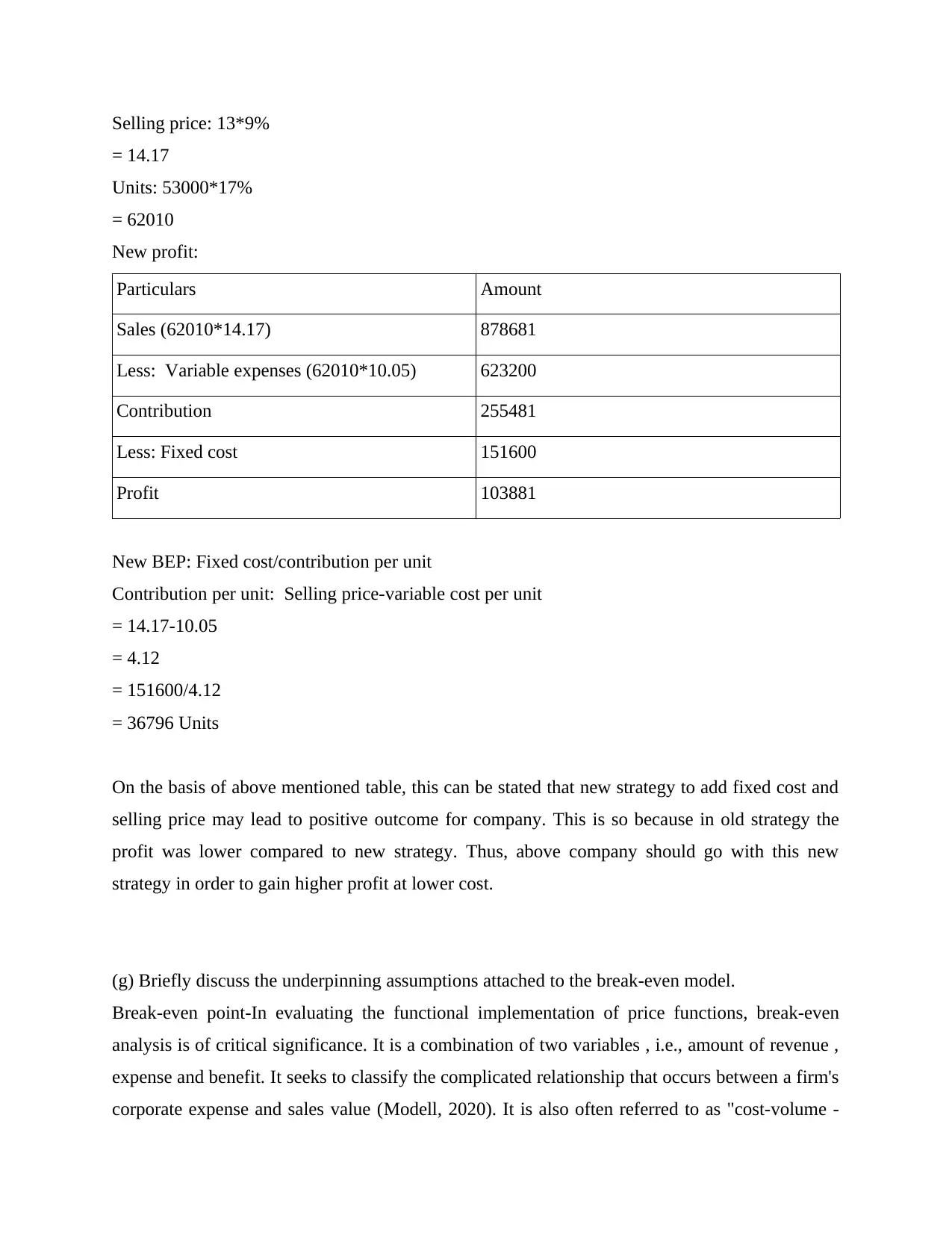
Selling price: 13*9%
= 14.17
Units: 53000*17%
= 62010
New profit:
Particulars Amount
Sales (62010*14.17) 878681
Less: Variable expenses (62010*10.05) 623200
Contribution 255481
Less: Fixed cost 151600
Profit 103881
New BEP: Fixed cost/contribution per unit
Contribution per unit: Selling price-variable cost per unit
= 14.17-10.05
= 4.12
= 151600/4.12
= 36796 Units
On the basis of above mentioned table, this can be stated that new strategy to add fixed cost and
selling price may lead to positive outcome for company. This is so because in old strategy the
profit was lower compared to new strategy. Thus, above company should go with this new
strategy in order to gain higher profit at lower cost.
(g) Briefly discuss the underpinning assumptions attached to the break-even model.
Break-even point-In evaluating the functional implementation of price functions, break-even
analysis is of critical significance. It is a combination of two variables , i.e., amount of revenue ,
expense and benefit. It seeks to classify the complicated relationship that occurs between a firm's
corporate expense and sales value (Modell, 2020). It is also often referred to as "cost-volume -
= 14.17
Units: 53000*17%
= 62010
New profit:
Particulars Amount
Sales (62010*14.17) 878681
Less: Variable expenses (62010*10.05) 623200
Contribution 255481
Less: Fixed cost 151600
Profit 103881
New BEP: Fixed cost/contribution per unit
Contribution per unit: Selling price-variable cost per unit
= 14.17-10.05
= 4.12
= 151600/4.12
= 36796 Units
On the basis of above mentioned table, this can be stated that new strategy to add fixed cost and
selling price may lead to positive outcome for company. This is so because in old strategy the
profit was lower compared to new strategy. Thus, above company should go with this new
strategy in order to gain higher profit at lower cost.
(g) Briefly discuss the underpinning assumptions attached to the break-even model.
Break-even point-In evaluating the functional implementation of price functions, break-even
analysis is of critical significance. It is a combination of two variables , i.e., amount of revenue ,
expense and benefit. It seeks to classify the complicated relationship that occurs between a firm's
corporate expense and sales value (Modell, 2020). It is also often referred to as "cost-volume -
⊘ This is a preview!⊘
Do you want full access?
Subscribe today to unlock all pages.

Trusted by 1+ million students worldwide
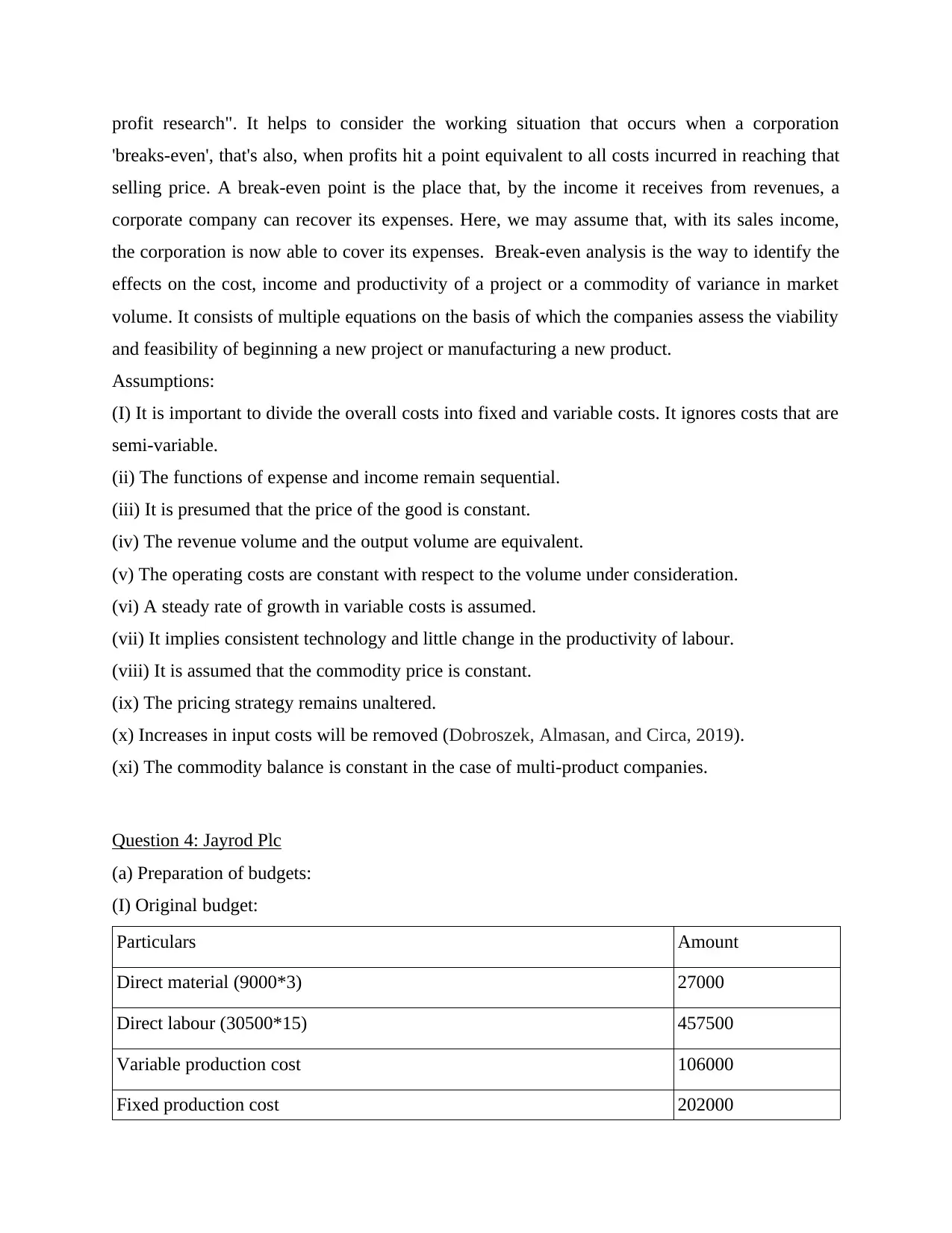
profit research". It helps to consider the working situation that occurs when a corporation
'breaks-even', that's also, when profits hit a point equivalent to all costs incurred in reaching that
selling price. A break-even point is the place that, by the income it receives from revenues, a
corporate company can recover its expenses. Here, we may assume that, with its sales income,
the corporation is now able to cover its expenses. Break-even analysis is the way to identify the
effects on the cost, income and productivity of a project or a commodity of variance in market
volume. It consists of multiple equations on the basis of which the companies assess the viability
and feasibility of beginning a new project or manufacturing a new product.
Assumptions:
(I) It is important to divide the overall costs into fixed and variable costs. It ignores costs that are
semi-variable.
(ii) The functions of expense and income remain sequential.
(iii) It is presumed that the price of the good is constant.
(iv) The revenue volume and the output volume are equivalent.
(v) The operating costs are constant with respect to the volume under consideration.
(vi) A steady rate of growth in variable costs is assumed.
(vii) It implies consistent technology and little change in the productivity of labour.
(viii) It is assumed that the commodity price is constant.
(ix) The pricing strategy remains unaltered.
(x) Increases in input costs will be removed (Dobroszek, Almasan, and Circa, 2019).
(xi) The commodity balance is constant in the case of multi-product companies.
Question 4: Jayrod Plc
(a) Preparation of budgets:
(I) Original budget:
Particulars Amount
Direct material (9000*3) 27000
Direct labour (30500*15) 457500
Variable production cost 106000
Fixed production cost 202000
'breaks-even', that's also, when profits hit a point equivalent to all costs incurred in reaching that
selling price. A break-even point is the place that, by the income it receives from revenues, a
corporate company can recover its expenses. Here, we may assume that, with its sales income,
the corporation is now able to cover its expenses. Break-even analysis is the way to identify the
effects on the cost, income and productivity of a project or a commodity of variance in market
volume. It consists of multiple equations on the basis of which the companies assess the viability
and feasibility of beginning a new project or manufacturing a new product.
Assumptions:
(I) It is important to divide the overall costs into fixed and variable costs. It ignores costs that are
semi-variable.
(ii) The functions of expense and income remain sequential.
(iii) It is presumed that the price of the good is constant.
(iv) The revenue volume and the output volume are equivalent.
(v) The operating costs are constant with respect to the volume under consideration.
(vi) A steady rate of growth in variable costs is assumed.
(vii) It implies consistent technology and little change in the productivity of labour.
(viii) It is assumed that the commodity price is constant.
(ix) The pricing strategy remains unaltered.
(x) Increases in input costs will be removed (Dobroszek, Almasan, and Circa, 2019).
(xi) The commodity balance is constant in the case of multi-product companies.
Question 4: Jayrod Plc
(a) Preparation of budgets:
(I) Original budget:
Particulars Amount
Direct material (9000*3) 27000
Direct labour (30500*15) 457500
Variable production cost 106000
Fixed production cost 202000
Paraphrase This Document
Need a fresh take? Get an instant paraphrase of this document with our AI Paraphraser
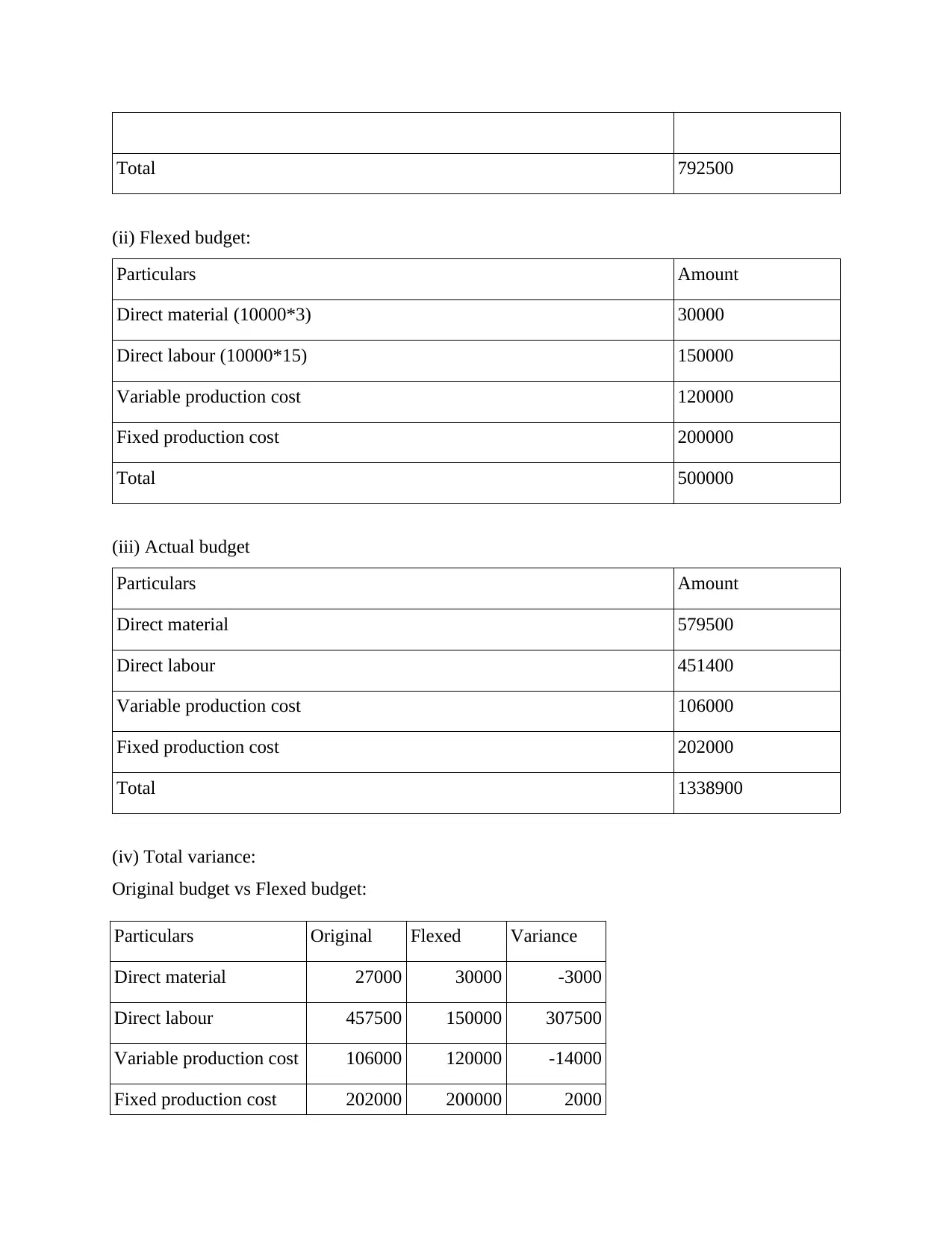
Total 792500
(ii) Flexed budget:
Particulars Amount
Direct material (10000*3) 30000
Direct labour (10000*15) 150000
Variable production cost 120000
Fixed production cost 200000
Total 500000
(iii) Actual budget
Particulars Amount
Direct material 579500
Direct labour 451400
Variable production cost 106000
Fixed production cost 202000
Total 1338900
(iv) Total variance:
Original budget vs Flexed budget:
Particulars Original Flexed Variance
Direct material 27000 30000 -3000
Direct labour 457500 150000 307500
Variable production cost 106000 120000 -14000
Fixed production cost 202000 200000 2000
(ii) Flexed budget:
Particulars Amount
Direct material (10000*3) 30000
Direct labour (10000*15) 150000
Variable production cost 120000
Fixed production cost 200000
Total 500000
(iii) Actual budget
Particulars Amount
Direct material 579500
Direct labour 451400
Variable production cost 106000
Fixed production cost 202000
Total 1338900
(iv) Total variance:
Original budget vs Flexed budget:
Particulars Original Flexed Variance
Direct material 27000 30000 -3000
Direct labour 457500 150000 307500
Variable production cost 106000 120000 -14000
Fixed production cost 202000 200000 2000
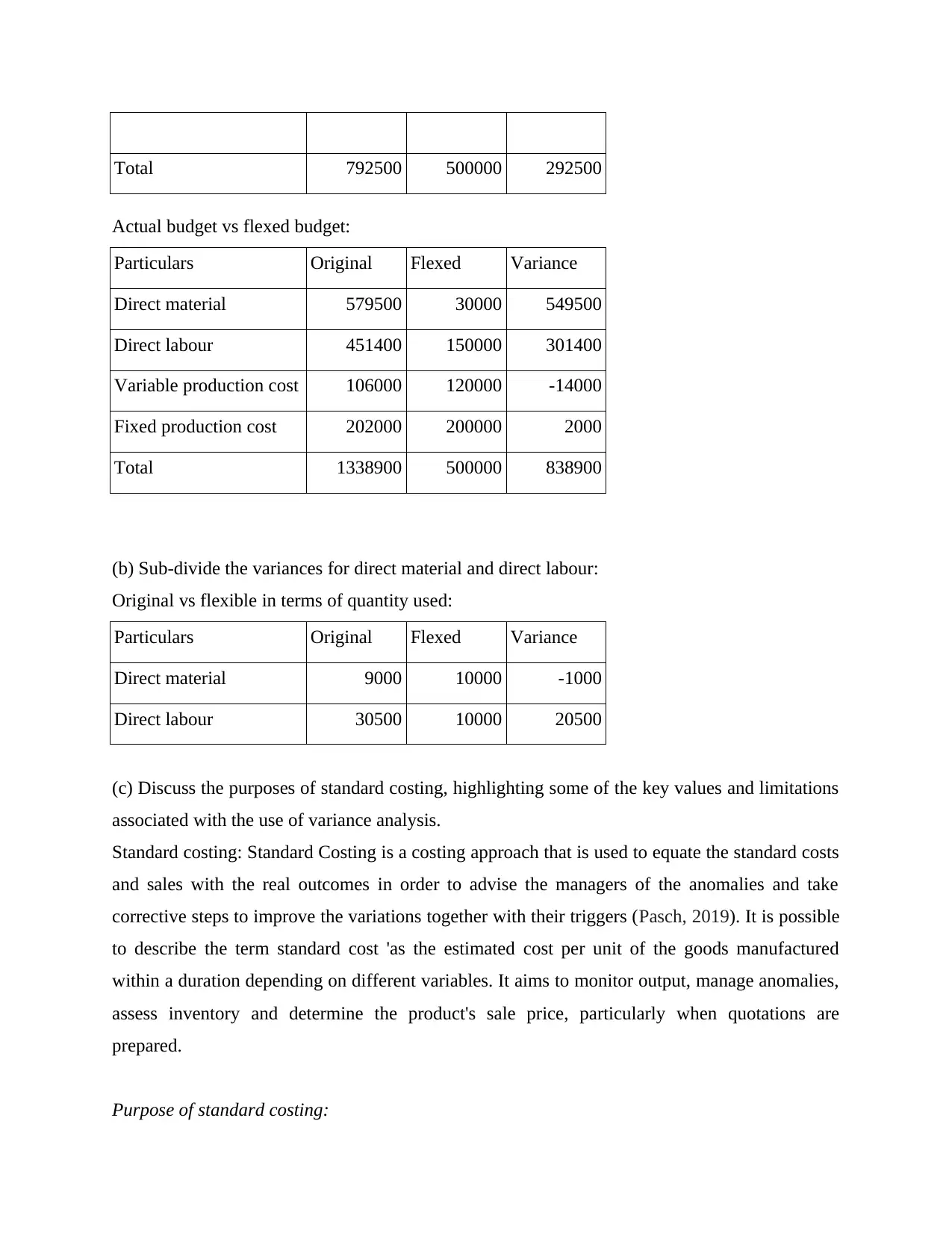
Total 792500 500000 292500
Actual budget vs flexed budget:
Particulars Original Flexed Variance
Direct material 579500 30000 549500
Direct labour 451400 150000 301400
Variable production cost 106000 120000 -14000
Fixed production cost 202000 200000 2000
Total 1338900 500000 838900
(b) Sub-divide the variances for direct material and direct labour:
Original vs flexible in terms of quantity used:
Particulars Original Flexed Variance
Direct material 9000 10000 -1000
Direct labour 30500 10000 20500
(c) Discuss the purposes of standard costing, highlighting some of the key values and limitations
associated with the use of variance analysis.
Standard costing: Standard Costing is a costing approach that is used to equate the standard costs
and sales with the real outcomes in order to advise the managers of the anomalies and take
corrective steps to improve the variations together with their triggers (Pasch, 2019). It is possible
to describe the term standard cost 'as the estimated cost per unit of the goods manufactured
within a duration depending on different variables. It aims to monitor output, manage anomalies,
assess inventory and determine the product's sale price, particularly when quotations are
prepared.
Purpose of standard costing:
Actual budget vs flexed budget:
Particulars Original Flexed Variance
Direct material 579500 30000 549500
Direct labour 451400 150000 301400
Variable production cost 106000 120000 -14000
Fixed production cost 202000 200000 2000
Total 1338900 500000 838900
(b) Sub-divide the variances for direct material and direct labour:
Original vs flexible in terms of quantity used:
Particulars Original Flexed Variance
Direct material 9000 10000 -1000
Direct labour 30500 10000 20500
(c) Discuss the purposes of standard costing, highlighting some of the key values and limitations
associated with the use of variance analysis.
Standard costing: Standard Costing is a costing approach that is used to equate the standard costs
and sales with the real outcomes in order to advise the managers of the anomalies and take
corrective steps to improve the variations together with their triggers (Pasch, 2019). It is possible
to describe the term standard cost 'as the estimated cost per unit of the goods manufactured
within a duration depending on different variables. It aims to monitor output, manage anomalies,
assess inventory and determine the product's sale price, particularly when quotations are
prepared.
Purpose of standard costing:
⊘ This is a preview!⊘
Do you want full access?
Subscribe today to unlock all pages.

Trusted by 1+ million students worldwide
1 out of 16
Your All-in-One AI-Powered Toolkit for Academic Success.
+13062052269
info@desklib.com
Available 24*7 on WhatsApp / Email
![[object Object]](/_next/static/media/star-bottom.7253800d.svg)
Unlock your academic potential
Copyright © 2020–2025 A2Z Services. All Rights Reserved. Developed and managed by ZUCOL.